CLOCKING THE FOURS
A NEW THEORY ABOUT IIII
|
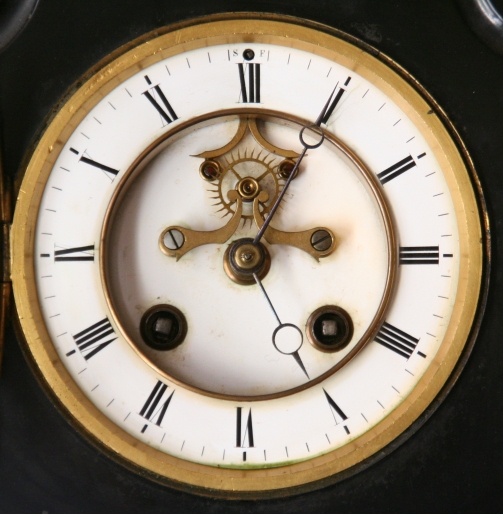 |
Why is the number 4 on a clock face depicted as IIII
and not as IV? In almost every other use, the Roman for 4 is IV not IIII. But
although the question is simple, there is no easy or definite answer.
One common
suggestion is that around the circle the IIII balances the VIII which is in its
mirror-symmetrical place – that is if a mirror was placed vertically between
the XII and VI, the VIII and IIII would reflect on to each other.
This classic clock face shows the attraction of
this theory. With the thick descending strokes and thin ascenders used in
this 19th century French enamel face, the IIII and the VIII do balance
each other well. But there are problems with this explanation. Although
the IIII balances the VIII, the V does not balance the VII, nor the I the
XI.
|
Another plausible explanation might be that IV has three strokes and is more
likely than IIII to be confused with the neighbouring III or it could be confused with the
upside down VI. Recognition is made harder by the fact that all are at
unfamiliar angles to the reader. However, watch and clock faces that have no
numerals show that the time is easily recognised by the angle of the hands
alone.
One correspondent even suggested that Parliament held the copyright on using
IV and charged a fee to any clockmaker imitating it, so hey all used IIII
instead. That is, of course, nonsense. But it fills the vacuum left because none of these suggestions really offers an adequate explanation of why
the normal rules of writing Roman numerals have been broken.
I think the answer is rather different. Artefacts in Wells Cathedral in Somerset, England indicate that it
is the question that may be based on a false assumption. Have the normal rules of writing Roman
numerals been broken? Or does the dial of a clock
simply use the normal
rules which were used when the clock face was first drawn in the 14th century?
It is worth remembering that when the idea of a mechanism rotating hands to
indicate the passage of time was invented, the means by which the pointers
showed the time had to be designed.
The oldest surviving clock-face in its original condition is on the clock
inside Wells Cathedral in Somerset. It dates from before 1392 and the original
mechanism – now in the Science Museum – has some claim to be the oldest
surviving clock works in the world. The current mechanism that drives it is
Victorian, but the face has not been changed for more than 600 years.
Look at the official image of the clock here
On this oldest
example the innermost circle shows the age of the Moon – and uses Arabic numerals
from 1 to 30. The next ring shows the minutes and uses Arabic numerals in groups
of five 5, 10, 15, 20, 25, 30, 35, 40, 45, 50, 55 with 60 at the top. The
intermediate minutes are shown by vertical stroke like a I.
The outermost circle is more than six feet (1.93m) in diameter and around it,
in Roman numerals, are the twenty four hours of the day – noon is at the top
indicated by a red star with the Roman numerals in gothic script I II III IIII V
VI VII VIII IX X IX [this numeral has at some point apparently been fixed upside
down] down the right hand side. Midnight is indicated by another red star at the
bottom with I II III IIII V VI VII VIII IX X XI up the left hand side. Though it
has to be said that the IX is not very clearly drawn, looking confusingly like a
II.
But here we have the essential elements of the clock-face which have come
down to us over 600 years – roman numerals for the hours with the 4 indicated
by IIII; minutes and days depicted by Arabic numerals.
Clearly there is much less power here in the symmetrical balance argument –
the dial is not symmetrical anyway. The Arabic numerals do not balance and the
two or three stars in each sector of the clock-face are certainly not arranged
to match those in the sector opposite. So why is IIII used instead of IV?
The answer I believe is found in manuscripts in the Wells Cathedral library.
They show that the use of IIII – or more precisely iiii or iiij – for 4 was
commonplace even though 9 was normally depicted by IX or ix. In other words, the
subtractive principle was used for one but not the other.
·
A Chronicle of the early 12th Century –
certainly before 1135 – shows the line of English Kings not with their dates
but with the length of their reigns. Here are three from the
list
Adelardus xiiii
Edouardus fili xxiiii
Aylredus ix anni et vi ebdomadibus (9 years and 6 weeks)
·
A hundred odd years later, in the mid
1200s, a copy of the Liber Ethinmologiarum by St. Isidore of Seville (died
636) was written out. Liber V (Book 5) lists the contents of the section Of
the Lawgivers – of Divine and Human Laws. The verso of folio 36 lists 39
headings. It uses iiii exclusively for 4, but ix exclusively for 9.
·
Pages from a 15th century service book also
survive in the library. One page has notes in red ink above the text giving
numbers. Again, it uses iiij exclusively for numbers ending in ‘4’ and ix
for those ending in ‘9’. Two examples - lxxxiiij for 84 and lxix for
69.
So the clock-faces we see today could be the last surviving remnants of the
style used by the mediaeval scribes when writing Roman numerals.
Exceptions
The practice of
using IIII rather than IV on clock-faces is not universal. Even in the UK
examples of IV can be found, although they are extremely rare. One is the clock
in the south transept of Norwich Cathedral. Here are some others.
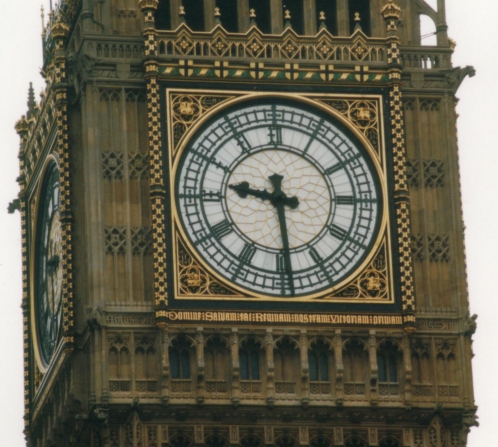 |
The well-known clock, commonly called Big Ben, at the
Palace of Westminster in London, where Parliament meets, has gothic style
Roman numerals round its face and the 4 is depicted as iv. It dates from
the 1850s. Strictly speaking, the hour bell is Big Ben, the clock is the
Great Clock, and the tower is the Clock Tower. The building is correctly
called the Palace of Westminster but most people refer to it as the Houses
of Parliament.
|
| Other examples of a four represented by IV on a clock face are rare in
Britain. This clock is on the Church of King Charles the Martyr
in Tunbridge Wells, Kent. |
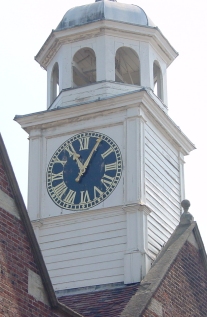
|
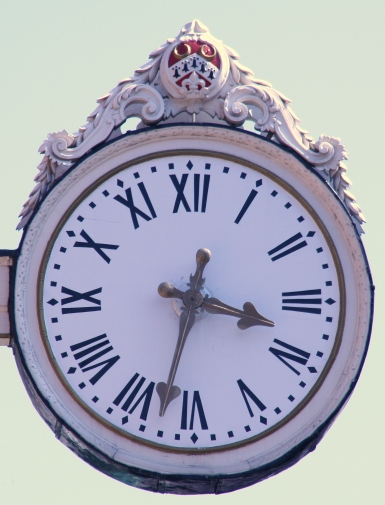 |
And this one is on the old Town Hall in Rochester, Kent.. |
However, outside the UK the position can be different. In Spain the use of IV is much more common, especially in clocks dating from the 18th and
19th century.
| This odd example with the numerals upright
rather than following the curve dates from the 19th century and is on the
tower of the cathedral of San Nicolas in Bilbao on Spain's north coast. |
 |
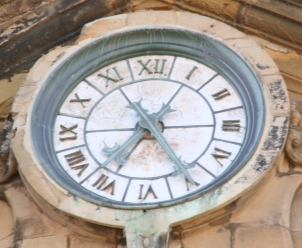 |
In neighbouring San Sebastian the Basilica Santa Maria at
the north of the town uses the IV while at the other end of the town the
clock on the Catedral del Buen Pastor uses the more traditional form. |
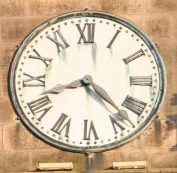 |
|
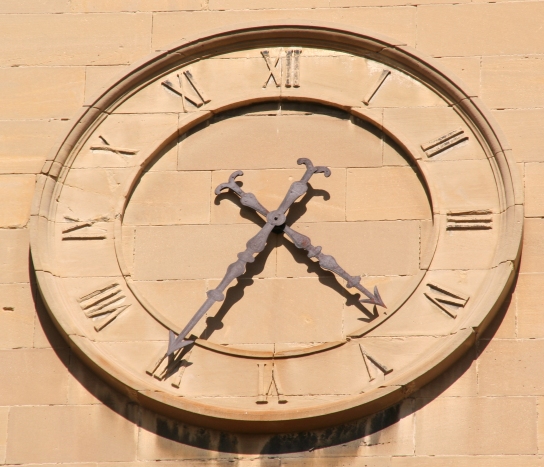 |
And to the south of San Sebastian, in Pamplona, where they
run the bulls through the streets every day for a week in July, the Catedral
de Santa Maria has this example of IV carved in stone. |
| This domestic example of the IV
was found in a second hand shop in Leòn
in 2005. |
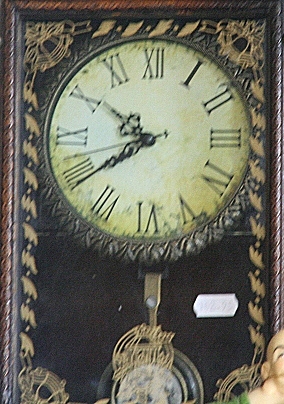 |
Clock-faces v.2.1 adding pictures and further details
15 August 2005
All material on these pages is © Paul Lewis 1999-2005